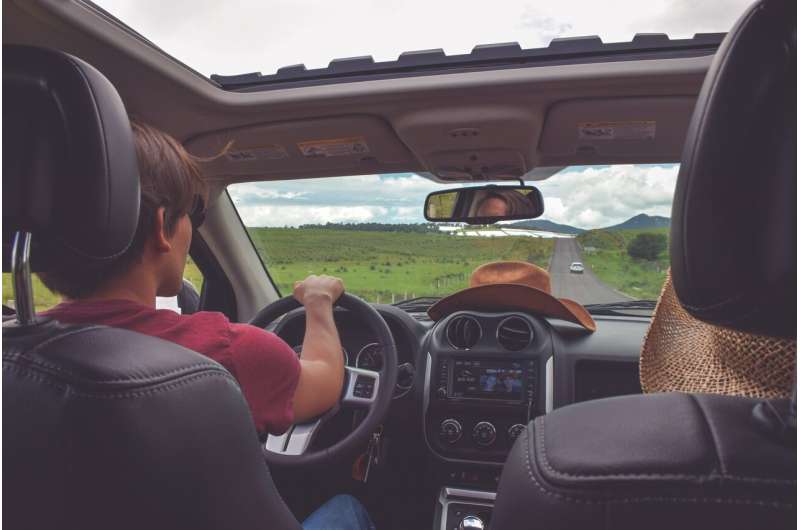This article has been reviewed according to Science X's editorial process and policies. Editors have highlighted the following attributes while ensuring the content's credibility:
fact-checked
trusted source
proofread
Want young drivers to slow down? Technology isn't the answer, says researcher

In 2021, young drivers under 26 made up just 14% of total drivers on NSW roads, but sadly represented almost a quarter of the state's road fatalities, according to Transport for NSW.
This is partly due to inexperience, but differences in brain development and psychological profiles also play a major role. We know that young brains are still developing right up until the age of 25, and that young people are more likely to take risks when making decisions and tend to have a sense of invincibility. And we also know that speeding is the biggest contributing factor in accidents among young drivers.
So how do you work with all that if you're trying to prevent young drivers being overrepresented in road fatalities and accidents?
This is a question that UNSW Sydney's Professor Brett Molesworth has been trying to answer for the past 13 years. It turns out that one of the most effective ways to make young people reduce speed and improve their overall driver safety is not through technology, but through good old-fashioned, verbal feedback.
"There's adaptive technology in motor vehicles that provides you with an auditory alert when you exceed the speed limit," Prof. Molesworth says.
"But when we tested its effectiveness with young drivers, we were amazed to see it had the opposite effect with young drivers—ironically, they exceeded the speed limit even more.
"And when we asked them, 'why didn't you adhere to the speed limit when you heard that auditory warning?' they basically told us they didn't like 'Big Brother' observing them and telling them how to drive and what to do."
Verbal feedback
Prof. Molesworth, who is part of UNSW Science's School of Aviation and has qualifications in aviation and psychology, says his research has shown that young drivers respond best to verbal feedback from a real person after completing a stint of driving, either in a simulator, or in the real world.
For Prof. Molesworth's research, the young drivers who complete a series of driving tests are assessed and then provided with a summary of their driving behavior in a verbal debriefing session.
Prof. Molesworth says he and his fellow researchers have developed a quick and effective training method that gives young drivers verbal feedback about their driving behavior that involves three components.
- How much they exceeded the speed limit.
- The safety implications associated with exceeding the speed limit, and
- The financial implications associated with being booked for speeding, as well as explaining how many demerit points they would lose.
"For example we might say, 'do you realize during this drive, the maximum speed that you traveled was 75 kilometers per hour in a 70 zone, and you've exceeded the speed limit by five kilometers an hour? Doing so will increase your distance required to stop, and it increases the likelihood of being involved in an accident. For that breach, you will be penalized $300 and lose two demerit points from your license.'
"That information provided verbally seems to be the most effective way to reduce young drivers' tendency to speed. So they exceed the speed limit far less, and that lasts for up to six months, according to the latest research," Prof. Molesworth says.
When the young drivers received their debriefings via written feedback or by electronic devices, they were less likely to adapt to the new learnings and curb their tendency to speed.
Learner logbooks
One way that the research findings about verbal feedback could help current practice is by having a verbal component as part of a young driver's training while on their L plates.
"Every learner has a logbook where they record the hours they've driven, the conditions, the distance and whether it's day or night driving," Prof. Molesworth says.
"We would like a little section where they get feedback from their supervising driver—usually a parent or caregiver– that they then reflect on. In other words, self-evaluate their performance based on that feedback."
Prof. Molesworth intends to test this in future research, as well as using eye-tracking technology to observe where young drivers are looking while they're driving. He observed in one of his studies that young drivers infrequently looked at the speedometer while driving.
"What we are trying to do is test the effectiveness of various eye-scanning patterns with young drivers to see if we can educate them about where to look, and importantly, the duration of what they need to look at.
"Importantly, we want to make sure that the focus on the speedometer is not detrimental to something outside the vehicle. And we'd like to be able to come up with training that builds upon our verbal feedback about speeding that also takes into account hazard management."
Provided by University of New South Wales



















